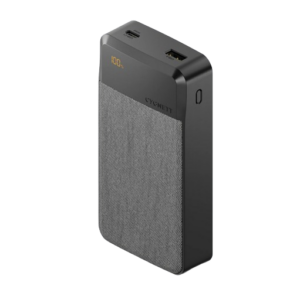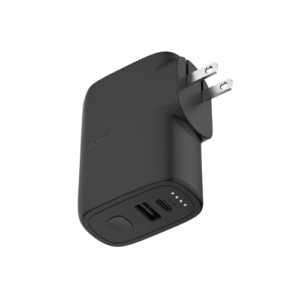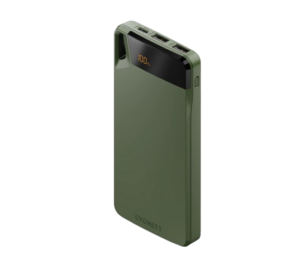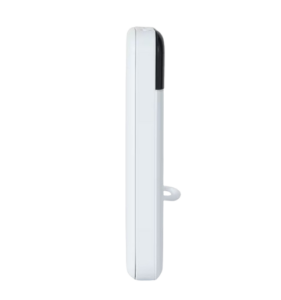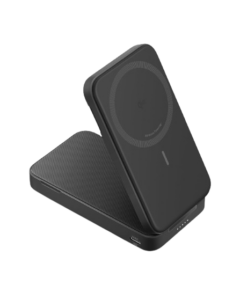A chunky charger that feels like a carpet.
Cygnett ChargeUp Reserve 3 review
If there's a single overarching theme that ties together Cygnett's approach to portable chargers, it's the idea that style can matter just as much as specs or smart design. Mundane gadgets don't have to look boring, so long as they can still get the job done.
Where the ChargeUp Boost 4 went all in on color, the ChargeUp Reserve favors fabric and faster charging speeds. That pivot different might not please everyone, but it doesn't hurt that it's one that anyone can feel.
How much does the Cygnett ChargeUp Reserve cost in Australia?
In Australia, the Cygnett ChargeUp Reserve 3 starts at $79.95 for the smallest 10,000mAh variant. There is also a larger 20,000mAh model available for those who want a little more to work with.
For a sense of how these two versions of the Cygnett ChargeUp Reserve 3 compare when it comes to price and performance, see below.
Cygnett ChargeUp Reserve 3: Design and features

The Cygnett ChargeUp Reserve is now in its third incarnation, but its easy to spot the similarities to the power banks that came before it. Like the previous model, this particular portable charger integrates fabric for a more premium and tactile feel-factor. This material covers around 75% of the front-facing half of the device and almost 100% of the back of it.
As with its predecessors, the ChargeUp Reserve 3 features a USB-A and USB-C port on one end plus a secondary USB-C port on one of its edges. Only one of these ports is usable as an input, but all three are usable as outputs.
There's no support for wireless charging here, but that's not exactly a surprise or disappointment. Cygnett has yet to get into the game when it comes to wireless chargers that are Made for MagSafe or MagSafe Compatible and while the ChargeUp Reserve might look the part, the hardware favors a more old-school approach. That said, there are a few key differences between this version of the power bank and the ones that came before it.
This time around, the power key is still found on the right-most side of the ChargeUp Reserve. However, it's pill-shaped rather than circular. The silver(ish) banding on the sides has also been traded out for a more smudge-resistant plastic.
Another big change here is the digital display. Like many Cygnett power banks, the ChargeUp Reserve 3 allows you to check how much charge remains at a glance and to a percentage point. You do this by pressing the power key, which will then make that percentile figure visible through the plastic shell. It's a cool effect that doesn't infringe on the sleek two-tone design here, though the lighting itself can be difficult to discern in brighter environments.
In terms of color, the ChargeUp Reserve comes in black and green. The unit we reviewed came in the former but I do like the contrast and visual punch of the alternative. In either case, you've also got two sizes to size up.
The bulkier model comes with 20,000mAh of bonus battery life while the slimmer one comes with just 10,000mAh. There are tangible benefits to both though. Some might prefer to work with a small amount of extra battery life if it means having a more lightweight brick to carry around.
All told, the 10,000mAh version of the ChargeUp Reserve 3 is just under half the weight of its heavy-duty sibling. Regardless of the size or shade you settle on, you'll also get a (very short) USB-C to USB-C cable and a warranty included in the box.
Cygnett ChargeUp Reserve 3: Performance

As with other Cygnett power banks, the ChargeUp Reserve 3 comes charged out of the box. That's not quite a game-changer but it is nice to know if you're looking to pick one up on short notice.
While the aesthetics of the unit scream simplicity, there are a few nuances to the charging setup here. As mentioned, just one of the three ports is an input. This detail is embossed next to that particular USB-C port, which supports speeds of up to 30W. The secondary USB-C port on the ChargeUp Reserve 3 supports half that, at 15W. Last but not least, the lone USB-A port clocks in at 18W of output.
While that all adds up to around 60W, potential purchasers of this particular power may want to remember that the total output at any given moment is capped at 30W. If you're charging multiple things at once, expect to see those speeds throttled.
What's here is pretty fast, though it is a far cry from the upper limits of what USB-C charging can technically offer. It likely won't be fast enough for those looking to take full advantage of their phone's respective fast-charging features but if you're a little less inclined towards maximisation I can't imagine it being that hard a pill to swallow.
Even if it isn't breaking records, the ChargeUp Reserve 3 rarely falls short of what you'd expect from it in terms of everyday usage and performance.
Cygnett ChargeUp Reserve 3: Is it worth the money?

I can't really say that Cygnett's ChargeUp Reserve 3 gets anything wrong about what you want from a power bank. Then again, there's not much to get wrong and it's far from the thriftiest way to deal with your everyday battery-based anxiety.
I like the design and I do appreciate that it can rev up to 30W of fast-charging. However, given the caliber of the competition it feels hard to reconcile the experience you're getting here with the price you're paying for. I don't think anyone buying the ChargeUp Reserve 3 will come away disappointed with the results it delivers, but nor do I think that those who choose not too take their chances elsewhere are missing out on all that much.
The Cygnett ChargeUp Reserve 3 is a standout power bank, but it doesn't do a whole lot to stand out if you know what I mean.
Related Articles




